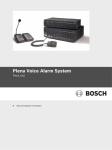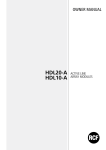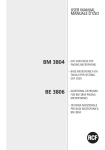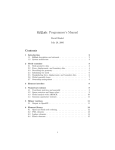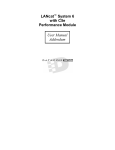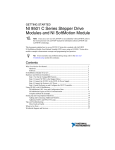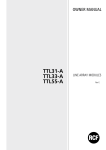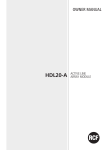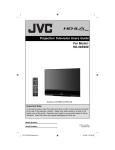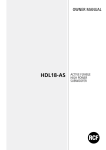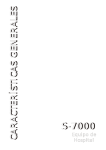Download USER MANUAL
Transcript
USER MANUAL MU 9186 --DXT 9000 – EVACUATION / PAGING AUDIO SYSTEM --MU 9186 – MAIN UNIT 4 5 6 10 11 12 16 21 23 23 25 25 30 31 32 SAFETY PRECAUTIONS NOTES ABOUT AUDIO SIGNAL CABLES DXT 9000 SYSTEM DESCRIPTION MU 9186 MAIN UNIT DESCRIPTION 19” RACK INSTALLATION FRONT PANEL REAR PANEL MAIN MENU AND ACCESS LEVELS EVENT MENU DISABLE-SURV MENU AUDIO SET MENU -- AUDIO SET > INPUTS SUBMENU -- AUDIO SET > OUTPUTS SUBMENU -- AUDIO SET > MP3 & MONIT SUBMENU -- AUDIO SET > ROUTN PROG SUBMENU 33 34 -- AUDIO SET > RTNG & PRST SUBMENU 34 35 36 36 37 40 42 43 44 INFO MENU SYS LOG MENU SYS CONFIG MENU 45 46 48 49 50 -- AUDIO SET > ZONE VOL SUBMENU -- SYS CONFIG > ZONE-GRP SUBMENU -- SYS CONFIG > PAG CONS SUBMENU -- SYS CONFIG > GPI-VOX SUBMENU -- SYS CONFIG > GPO SUBMENU -- SYS CONFIG > REM-N&D SUBMENU -- SYS CONFIG > SETTINGS SUBMENU 54 DISPLAY LISTS DISPLAY TEXT MESSAGES MU 9186 – JUMPER SETTINGS CONNECTION EXAMPLE GUIDANCE ON THE MEASUREMENT OF THE SPEAKER LINE IMPEDANCE SPECIFICATIONS 55 APPENDIX ENGLISH TABLE OF CONTENTS ENGLISH SAFETY PRECAUTIONS IMPORTANT Before connecting and using this product, please read this instruction manual carefully and keep it on hand for future reference. The manual is to be considered an integral part of this product and must accompany it when it changes ownership as a reference for correct installation and use as well as for the safety precautions. RCF S.p.A. will not assume any responsibility for the incorrect installation and / or use of this product. IMPORTANT WARNING: To prevent the risk of fire or electric shock, never expose this product to rain or humidity. This device is intended for indoor use only. WARNING SAFETY PRECAUTIONS 1. All the precautions, in particular the safety ones, must be read with special attention, as they provide important information. 2.1 PRIMARY POWER SUPPLY FROM MAINS -- The mains voltage is sufficiently high to involve a risk of electrocution: never install or connect this product when its power cord is plugged in. -- Before powering up, make sure that all the connections have been made correctly and the voltage of your mains corresponds to the voltage shown on the rating plate on the unit, if not, please contact your RCF dealer. -- This apparatus can be connected to either TT or TN earthing arrangements only. -- The metallic parts of the unit are earthed by means of the power cord. An apparatus with CLASS I construction shall be connected to a mains socket outlet with a protective earthing connection. -- This apparatus shall be connected to a facility equipped device to protect against earth faults, appropriately sized for the type and power of the installed line (RCD). -- Protect the power cord from damage. Make sure it is positioned in a way that it cannot be stepped on or crushed by objects. -- To prevent the risk of electric shock, never open this product: there are no parts inside that the user needs to access. -- The mains plug is used to disconnect the device and it shall remain readily operable. 2.2 SECONDARY (/ EMERGENCY) POWER SUPPLY THROUGH BATTERIES -- The apparatus operating voltage is 48 V dc (therefore, it is necessary to connect in series several batteries having a lower nominal voltage, example: 4 x 12 V, 2 x 24 V). -- Always use rechargeable batteries, which need to be chosen according to the maximum possible load. -- Verify the polarity of batteries is correct. -- Do NOT short-circuit batteries (i.e. connecting the 2 opposite poles together with metallic wires). -- The 48 V dc plug is used to disconnect the device and it shall remain readily operable. -- The 48 V dc power supply does not go beyond the fact that there are dangerous voltages inside the unit. -- Throw empty batteries away according to your country laws about ecology and environment protection. 3. Make sure that no objects or liquids can get into this product, as this may cause a short circuit. This apparatus shall not be exposed to dripping or splashing. No objects filled with liquid (such as vases) and no naked sources (such as lighted candles) shall be placed on this apparatus. 4. Never attempt to carry out any operations, modifications or repairs that are not expressly described in this manual. Contact your authorized service centre or qualified personnel should any of the following occur: -- The product does not function (or functions in an anomalous way). -- The power cord has been damaged. -- Objects or liquids have got into the product. -- The product has been subject to a heavy impact. 5. If this product is not used for a long period, disconnect its power cord and batteries. 6. If this product begins emitting any strange odours or smoke, switch it off immediately and disconnect its power cord and batteries. 4 ENGLISH 7. The terminals marked with the symbol are HAZARDOUS LIVE and their connection is to be made by an INSTRUCTED PERSON or the use of ready-made cables is required. 8. Do not connect this product to any equipment or accessories not foreseen. For suspended installation, only use the dedicated anchoring points and do not try to hang this product by using elements that are unsuitable or not specific for this purpose. Also check the suitability of the support surface to which the product is anchored (wall, ceiling, structure, etc.), and the components used for attachment (screw anchors, screws, brackets not supplied by RCF etc.), which must guarantee the security of the system / installation over time, also considering, for example, the mechanical vibrations normally generated by transducers. To prevent the risk of falling equipment, do not stack multiple units of this product unless this possibility is specified in this user manual. 9. RCF S.p.A. strongly recommends this product is only installed by professional qualified installers (or specialised firms) who can ensure correct installation and certify it according to the regulations in force. The entire audio system must comply with the current standards and regulations regarding electrical systems. 10. Supports and trolleys The equipment should be only used on trolleys or supports, where necessary, that are recommended by the manufacturer. The equipment / support / trolley assembly must be moved with extreme caution. Sudden stops, excessive pushing force and uneven floors may cause the assembly to overturn. 11. Mechanical and electrical factors need to be considered when installing a professional audio system (in addition to those which are strictly acoustic, such as sound pressure, angles of coverage, frequency response, etc.). 12. Hearing loss Exposure to high sound levels can cause permanent hearing loss. The acoustic pressure level that leads to hearing loss is different from person to person and depends on the duration of exposure. To prevent potentially dangerous exposure to high levels of acoustic pressure, anyone who is exposed to these levels should use adequate protection devices. When a transducer capable of producing high sound levels is being used, it is therefore necessary to wear ear plugs or protective earphones. See the technical specifications in loudspeaker instruction manuals to know their maximum sound pressure levels. 13. Do not obstruct the ventilation grilles of the unit. Situate this product far from any heat sources and always ensure adequate air circulation around the ventilation grilles. 14. Do not overload amplifiers. Check that amplifier outputs are not shorted. 15. Never force the control elements (keys, knobs, etc. ). 16. Do not use solvents, alcohol, benzene or other volatile substances for cleaning the external parts of this product. Use a dry cloth. WARNING: Any change made by unauthorized personnel to the product and / or the system (in which it is installed and configured, including rack cabinet and wiring) may invalidate the CE marking (certification EN5416: 2008) and also the product warranty. NOTES ABOUT AUDIO SIGNAL CABLES To prevent the occurrence of noise on microphone / line signal cables, use screened cables only and avoid putting them close to: -- Equipment that produces high-intensity electromagnetic fields. -- Mains cables. -- Loudspeaker lines. 5 ENGLISH RCF S.P.A. THANKS YOU FOR PURCHASING THIS PRODUCT, WHICH HAS BEEN MADE TO GUARANTEE RELIABILITY AND HIGH PERFORMANCE. DXT 9000 SYSTEM DESCRIPTION DXT 9000 is a monitored digital paging / evacuation system in compliance with EN 54-16 and ISO 7240-19 that allows a completely scalable and versatile range of configurations and solutions. It features a double-ring topology approach: a first simple ring for the small and medium size systems and a second larger ring supported by a main unit with router (MU 9186/R) for large and extra-large applications, always plug & play and easy-configurable. For instance, a small system can be designed by using only one MX 9502 / MX 9504 main unit, which already includes all the necessary controls and two 250 W (MX 9502) / four 125 W (MX 9504) class D power amplifiers (having 100 V / 70 V constant voltage loudspeaker lines). 100 V / 70 V LOUDSPEAKERS 100 V / 70 V LINES MX 9504 A system that requires a higher output power or a larger number of zones can be obtained by adding one or more system amplifiers model UP 9501 (1 x 500 W), UP 9502 (2 x 250 W) or UP 9504 (4 x 125 W) to the MX 9502 / MX 9504, connected through the dedicated RCF FLEXCOM data-link port. 100 V / 70 V LOUDSPEAKERS 100 V / 70 V LINES MX 9504 100 V / 70 V LINES 100 V / 70 V LOUDSPEAKERS UP 9501 MU 9186 is another main unit model similar to MX 9502 / MX 9504, but without internal power amplifiers. Since data wiring may have critical connections, for instance due to cable type and length, RCF FLEXCOM bus can adapt the data communication speed to the wiring characteristics and available data band. Only a few devices are necessary to design the simplest and the most complex projects, centralized or distributed: no matter if a supermarket or a theatre, an airport or a shopping centre, a fast-food or an underground, a school or a hospital. 6 ENGLISH Diagnostic functions and fault reporting meet all evacuation system requirements. Wiring is limited to a twin pair J-type fire-rated cable for most of connections and to a fourpair J-type fire-rated cable to link paging microphones. The system configuration can be edited on the main unit front panel (for small systems), but it can also be made through a local or remote PC, by using a dedicated graphic user interface software. The dual power supply allows both AC and DC operation. The ‘RCF D+ Class’ power amplifier technology and recover-fall-back built-in facility make the DXT 9000 a highly secure, reliable and safe system. Each DXT 9000 unit is equipped with an RS 485 serial port to be used for the dedicated system programmable remote controls. Noise detection devices work on RS 485 port as well. Two pre-recorded messages can be simultaneously played and sent to the DXT 9000 network from main units, which can store both emergency messages (to a checked dedicated memory) and routine messages (on separated SD cards). Another SD/USB support is used as MP3 player (to play background music). The Ethernet port (on main units) allows to get the complete remote control of the whole system. DXT 9000 devices have programmable logic inputs and outputs, checked by the system itself or by the connected security/emergency devices, such as fire alarm systems. Each component has its own digital address. DXT 9000 includes high quality digital components already in use for RCF professional audio systems, obtaining high performances and qualifying the DXT 9000 system for installations in places that require a very good sound reproduction, such as theatres and auditoriums. DXT 9000 SYSTEM COMPONENTS ------------ MX 9502 MX 9504 MU 9186 MU 9186/R UP 9501 UP 9502 UP 9504 BM 9804 BM 9802 BE 9808 TS 9918 Main unit including two 250 W class D amplifiers inside Main unit including four 125 W class D amplifiers inside Main unit (no power amplifiers inside) Main unit with router (no power amplifiers inside) Unit with a single 500 W class D amplifier Unit with two 250 W class D amplifiers Unit with four 125 W class D amplifiers Paging microphone with zone selection Paging microphone with zone selection through numeric keyboard Additional 8-zone keyboard for paging microphones Remote level control and programme selector 7 ENGLISH EXAMPLE: SYSTEM WITH MX 9504 MAIN UNIT FALLBACK EMERGENCY MIC. FIRE ALARM SYSTEM PAGING MIC. BM 9802 BM 9804 + BE 9808 100 V / 70 V LOUDSPEAKERS LINES MX 9504 PC MUSIC SOURCES EXAMPLE: SYSTEM WITH MU 9186 MAIN UNIT FALLBACK EMERGENCY MIC. PAGING MIC. BM 9802 BM 9804 + BE 9808 100 V / 70 V LOUDSPEAKERS LINES FIRE ALARM SYSTEM UP 9501 MU 9186 UP 9502 PC MUSIC SOURCES UP 9504 8 ENGLISH EXAMPLE: SYSTEM WITH NETWORK FALLBACK EMERGENCY MIC. PAGING MIC. BM 9802 BM 9804 + BE 9808 FIRE ALARM SYSTEM UP 9501 100 V / 70 V LOUDSPEAKER LINES MU 9186/R UP 9502 PC MUSIC SOURCES FALLBACK EMERGENCY MIC. PAGING MIC. BM 9802 BM 9804 + BE 9808 FIRE ALARM SYSTEM 100 V / 70 V LOUDSPEAKERS LINES UP 9502 MU 9186/R PC MUSIC SOURCES 9 ENGLISH MU 9186 MAIN UNIT DESCRIPTION MU 9186 is a main unit with audio inputs and outputs, a pre-recorded message player, control / surveillance functions, MP3 player. When used with 100 V / 70 V line loudspeakers, the MU 9186 needs to be combined with UP 9500 series amplifiers. The MU 9186 main unit can drive several UP 9500 series amplifiers. A UP 9501 amplifier can be set as ‘spare’ that automatically replaces a faulty one. MAIN FEATURES -- Configurable digital matrix. -- Fully monitored as according to the EN 54-16 and ISO 7240-19 standards. -- The zone configuration is virtual and can be set after the system installation. -- Two bus inputs for paging microphones. -- FALL-BACK input to connect an independent dedicated EVAC paging microphone. -- Digital signal processor on both inputs and outputs. A compressor can be inserted on the AUX and MAIN inputs. -- Evacuation messages (with priority) are stored to a checked and protected internal memory. Two messages (for evacuation, routine communications or advertisements) can be played simultaneously (to different zones). -- SD slot for cards with routine messages that can be triggered from GPI or the internal timer. -- MP3 player (with USB port and SD card slot) for background music. -- The BGM1 analogue audio input can be alternatively replaced by the MP3 player and the PAGING IN 2 input by the AUX INPUT. This can be made by using software presets. -- AUX and MONITOR audio outputs. -- Graphic user interface to set all system parameters directly from a PC through USB port. -- Front panel control with LCD. -- RCF-FLEXCOM technology digital Audio Bus to connect amplifiers (UP 9501, UP 9502, UP 9504). -- 12 GPI logic inputs (8 monitored and 4 optical) and 8 GPO logic outputs (relays). -- RS 485 serial port (screw terminals) for interfacing and monitoring. -- ETHERNET port (RJ 45 connector) for local area network (LAN) applications, local and remote system configuration. -- Optional programme selector and level remote control. -- AC and DC power supply. 10 ENGLISH BLOCK DIAGRAM 19” RACK INSTALLATION Fix the MU 9186 main unit to the front side of a 19” rack cabinet through 4 screws. Rack cabinets shall have: -- At least an IP 30 rating. -- A door with glass (or a thin metal mesh), through which the warning and emergency light indications are clearly visible (according to regulations). 11 ENGLISH MU 9186 – FRONT PANEL 6 27 7 8 10 28 3 3 29 9 3 5 3 30 1 31a 1 SYSTEM ON: button: press and hold to turn the MU 9186 main unit on (when off). This button also works as fault acknowledge: press it to remove the displayed fault indication. The SYSTEM ON button does not turn the main unit off. To switch the main unit off, make sure the 48 V dc power supply (batteries) is not present and use either the proper software function or the main POWER 52 switch on the rear panel. 2 ESC (‘Escape’) button: press to quit the displayed menu. 3 Six buttons to select the respective functions shown on the display. 4 CONTROL / SELECTION: rotary encoder and push-button to select. Turn the encoder clockwise to scroll the menu downwards or increase the selected parameter value. Turn it counterclockwise to scroll the menu upwards or decrease the selected parameter value. Press to select. 5 Display (LCD) 12 3 4 3 2 31b 11 19 12 20 13 21 14 22 15 23 16 24 17 25 18 26 ÷ 26 LEDs No. SILK SCREEN COLOUR INDICATION (WHEN LIT) FURTHER INFORMATION 6 AC PWR Green The mains power (AC) is present and the respective fuse is intact. If the LED is off, the mains power is not available (or out of range). 7 DC PWR Green 48 V dc power supply is present and the respective fuse is intact. If the LED is off, 48 V dc is not available (or out of range). 8 AUX PSU Green The main unit is turned on and its stand-by power supply unit operates properly. 9 SYSTEM OK Green No detected faults: the entire system is operating properly. The LED is lit when no faults are detected on any system device. If a logic input (GPI) is set to obtain a fault remote indication of an external device, a possible problem is indicated by the GENERAL FAULT LED. 10 GENERAL FAULT Yellow One or more faults have been detected, including problems on power supply, so it can be lit even if the AC PWR 6 and DC PWR 7 green LEDs are off. The LED gets lit even in case of failure of any peripheral unit. 11 FALL BACK EVENT Red An emergency announcement (with highest priority) is in progress through the FALL BACK INPUT 32 . Red The evacuation message is currently played. This LED also indicates the play of a message from a microphone or an external source activated as EMERGENCY (GPI set to EMERG). 12 ALARM 13 ALERT Yellow The alert message is currently played. This LED also indicates the play of a message from a microphone or an external source activated as ALERT (GPI set to ALERT). 14 QUIESCENT Green The device is switched on but not playing any audio signal. It simply indicates an idle state, as there is no audio signal. One or more device inputs, outputs or peripherals are disabled. This LED is lit only in case of one or more circuits and/or devices used for evacuation/emergency are disabled. In the case, for example, of a non-monitored paging microphone, its disabling will not make the LED get lit. Main unit emergency message player fault. Faulty memory or problems on the audio path (the internal message player is not properly linked to the system audio outputs). 15 16 DISABLEMENT MESSAGE FAULT Yellow Yellow ENGLISH 6 13 ENGLISH No. 17 18 19 14 SILK SCREEN COLOUR INDICATION (WHEN LIT) FURTHER INFORMATION SYSTEM FAULT Yellow Internal microprocessor reset. After rebooting, the LED will be off, but the reset event will remain in the SYSTEM / FAULT LOG. Yellow Power supply fault (internal power supply, internal boards or external power supply). A logic input (GPI) needs to be linked to the logic output of the external power supply unit and set to EXTERNAL EVENT FAULT. A possible external power supply unit fault is displayed as EXTERNAL PSU FAULT. Yellow Main unit local fault. This LED gets lit even in case of main power fault. This LED is lit in the faulty device only. For instance, if a SLAVE unit is faulty and the MASTER unit is properly operating, this LED is lit on the SLAVE unit only, while the SYSTEM FAULT 17 LED is lit on both MASTER and SLAVE units. If a logic input (GPI) is set to signal a possible fault of an external system, this will be indicated by the LOCAL FAULT LED (only in the unit where the logic input has been activated). On SLAVE units, it only indicates of the paging microphones connected to the FALL BACK input. PWR SUPPLY FAULT LOCAL FAULT 20 MICROPHONE FAULT Yellow An emergency paging microphone (among those connected to FALL BACK 32 or PAGING 1 41 / PAGING 2 42 inputs, if set to EMERGENCY in the software) is faulty. 21 AMPLIFIERs FAULT Yellow One or more amplifiers are faulty. 22 SPKR CIRCUITs FAULT Yellow One or more loudspeaker lines are faulty. 23 EARTH FAULT Yellow Loudspeaker line earth leakage. Earth leakage < 50 kΩ SILK SCREEN 24 COMM. PORT FAULT 25 LOGIC INPUT FAULT 26 LOGIC OUTPUT FAULT COLOUR INDICATION (WHEN LIT) FURTHER INFORMATION Yellow Hardware / RS 485 serial port (for linking to a fire alarm system) fault. This indication depends on either a broken / short-circuited cable or no data transmission (for example, due to a damaged serial port) or remote device unavailable. Yellow GPI fault. The LED gets lit when the logic input is monitored and its respective line is open or shorted. A logic input (GPI) needs to be monitored when linked to a fire alarm system (to activate pre-recorded messages remotely). Yellow GPO fault. The LED gets lit when the logic output is monitored and its respective line is open or shorted. A logic output (GPO) needs to be monitored when linked to a fire alarm system (for example, to signal an audio system fault to the fire alarm system). ENGLISH No. 27 MP3 player SD card slot. 28 USB port (type A) for USB flash drives (MP3 player). 29 MONITOR: 6.3 mm jack input (TRS) for headphones. 30 PC LINK: USB port (type B) to connect a PC that can be used to configure and manage the system. 31a Internal loudspeaker (monitor). 31b Internal buzzer for fault alert (or evacuation message in progress). It can be muted by pressing the SYSTEM ON 1 button. 15 ENGLISH MU 9186 – REAR PANEL 47 46 45 44 43 42 41 40 37 36 35 33 34 53 52 51 50 48 49 39 38 32 32 FALL BACK INPUT: monitored audio input (balanced, ‘line’ level, for removable connector) to be used for emergency announcements. This input can be used even in case of software crash. AUDIO – Audio signal (cold) + Audio signal (hot) GND – CMD + Audio signal ground Activation and monitoring contacts of the FALL BACK audio input. For monitoring purposes, the two CMD contacts should normally be powered by 24 V dc (voltage available from the 24 V DC 49 output. FALL BACK input state depends on presence and polarity of the voltage at the two CMD contacts. 16 STATE Voltage at the CMD contacts Description COMMAND KO No voltage The FALL BACK INPUT is not connected IDLE 24 V dc, direct polarity The FALL BACK INPUT is connected, but inactive ACTIVE 24 V dc, reverse polarity The FALL BACK INPUT is activated ENGLISH 33 MONITOR OUT audio output (RCA connector). 34 AUX OUT audio output (RCA connector). 35 BGM 1 audio input (dual RCA connector) for a ‘line’ level signal (i.e. CD / MP3 player, tuner). 36 MOH (‘Music On Hold’): parallel output of the BGM 1 35 input that can be connected , for example, to a phone system to get the ‘Music On Hold’. 37 BGM 2 audio input (dual RCA connector) for a ‘line’ level signal (i.e. CD / MP3 player, tuner). 38 BGM 3 audio input (dual RCA connector) for a ‘line’ level signal (i.e. CD / MP3 player, tuner). The two channels (left / right) of stereo signals on BGM 1 35 , BGM 2 36 and BGM 3 38 inputs are mixed in mono inside the device. The two channels (left / right) of the signal on BGM 1 35 input are directly sent to the MOH 36 parallel output, which is stereo. 39 AUX INPUT balanced audio input (removable connector). + Hot – Cold GND Ground 40 MAIN IN balanced audio input (removable connector). + Hot – Cold GND Ground MAIN IN can have the ‘VOX’ function enabled, which automatically detects the audio signal presence when above a predefined threshold. 17 ENGLISH 41 PAGING IN 1 input (RJ 45 connector) to link paging microphones. 42 PAGING IN 2 input (RJ 45 connector) to link paging microphones. PAGING 1 and PAGING 2 input pins: PIN PIN 1 Audio signal (+, hot) 5 Audio signal ground 2 Audio signal (–, cold) 6 Power supply + 28 V dc 3 Digital and power supply ground 7 RS 485 A (+) 4 Audio signal ground 8 RS 485 B (-) RJ 45 socket RJ 45 plug 43 ETHERNET port (RJ 45 socket) 44 ROUTINE MESSAGES: slot for SD cards including routine (non-emergency) message audio files. 45 CTRL RS485: RS 485 serial port (removable connector). 18 + RS 485 A (non-inverting) – RS 485 B (inverting) GND RS 485 (reference ground) 28V Power supply + 28 V dc GND Power supply ground ENGLISH 46 FLEXCOM BUS IN: data bus input (removable connector). 47 FLEXCOM BUS OUT: data bus output (removable connector). 48 GENERAL PURPOSE INPUTS 12 logic inputs (removable connectors), of which the first 8 are monitored and the last 4 with opto-isolators. The logical inputs 9 to 12 can be activated by connecting the 24 V DC 49 input. Possible logic states: inactive / active. output to each logic LOGIC INPUT 1 ÷ 8 STATES: STATE DETECTED RESISTANCE VALUE (R) OPEN Open line or too high resistance R > 15 kΩ SHORT Short-circuit or too low resistance R < 390 Ω IDLE Used logic input, but inactive 3.4 kΩ < R < 15 kΩ ACTIVE Activated logic input 390 Ω < R < 1.17 kΩ SUGGESTED RESISTORS TO BE ADDED TO GET LINE MONITORING: A B GPI (1-8) A B 470 Ω 10 kΩ 19 ENGLISH 49 24 V DC: 24 V dc output, max. 100 mA. 50 GENERAL PURPOSE OUTPUTS 8 logic outputs (relay dry contacts, removable connectors). JP 1 ÷ 8 C B Each logic output has two resistors that can be inserted by setting the respective jumper (JP1 to JP8) to the AB position. These two resistors are necessary when the logic output (GPO) is linked to a logic input (GPI) of another device and the line monitoring is required. The first resistor (470 Ω) is used to get the ACTIVE state, the second (10 kΩ) to get the IDLE state. If a jumper is set to the BC position, the two resistors are overridden (the internal relay contact is directly connected). Internal jumper setting needs to be carried out directly by either RCF or an authorised service centre. WARNING: DO NOT directly power a logic output (GPO) when the respective internal jumper is set to the AB position (inserted resistors), as the max. current is only 25 mA. If the jumper is set to the BC position, the max. current is 0.3 A. MAX APPLICABLE VOLTAGE: 24 V dc. 51 Power cord input (to be connected to a mains earthed socket only). 52 POWER switch (0 = OFF, I = ON). 53 Input for 48 V dc power supply (removable screw terminals) through batteries. Note: according to EN 54-16 standard, the backup power supply unit shall be installed into the same rack cabinet where there is the audio system with emergency purposes (or a system part) to which it is connected. The detection of 48 V dc power supply involves the implicit condition that the system is always turned on, thus not allowing shutdown of the main unit through the respective function in the menu, nor through the 20 POWER switch 52 . 470 A 10k GPO ENGLISH MAIN MENU AND ACCESS LEVELS Beside the display, there are 6 buttons 3 (3 on the left, 3 on the right) to select the correspondent displayed options. The ESC 2 button (below the display, on the right) allows to quit the displayed menu. 1 4 2 5 3 6 Turn and press the CONTROL SELECTION 4 encoder to select parameters and change their values. The software initial main menu is shown as MAIN in the top left-hand corner of the display. The complete menu path is indicated in the top of the display. In the display bottom: the date (on the left), the time (on the right) and the access level at the centre as follows: ----- L1 (level 1): users not allowed to configure the system L2 (level 2, password required): qualified personnel L3 (level 3, password required): system administrators L4 (level 4, RCF only): system maintenance Enter the password in the SYS LOG > LOGIN menu to login and obtain privileges of either level 2 or 3, in order to be allowed to enter other menus / parameters. Use the SYS LOG > LOGOUT to logout. ACCESS LEVEL 1 – USERS NOT ALLOWED TO CONFIGURE THE SYSTEM -- Level that allows to enter only a software section, in which it is not possible to edit the system configuration, for example (allowed operations): -- Adjust the MASTER volume (BGM or PAGING) -- Use the MP3 player -- Read the system information. -- The password is not required. ACCESS LEVEL 2 – QUALIFIED PERSONNEL (password required) -- Level that allows to (in addition to the level 1 functions): -- See the system logs -- Reset emergency events and faults -- Set messages that can be quickly activated through the 6 display buttons. 21 ENGLISH ACCESS LEVEL 3 – SYSTEM ADMINISTRATORS Level that allows to configure the system completely: evacuation, pre-recorded emergency messages, logic inputs / outputs (GPI/O), paging microphones, zones, groups, names, remote controls, amplifiers, calibrations, spare units, inputs gains, equalisations, background music (BGM) source selection, etc. . ACCESS LEVEL 4 – SYSTEM MAINTENANCE System maintenance by RCF service centres. After turning the system on, the display shows the MAIN page, from which it is possible to enter the six menus by pressing the respective buttons. There may be menus about current events (as faults or emergencies) that need to be visualised: these will be underlined (in this example, ‘SYS LOG’). Functions managed by each menu are briefly described in the following table: MENU DESCRIPTION 1 EVENT Action required to manage events (evacuation / alert / faults): RESET: it interrupts the event (LED, LCD, audio) SILENT: it mutes the audio signal REACTIVATE: it restores the audio signal LIVE MESSAGE: message playback manual activation. 2 DISABL-SURV 3 AUDIO SET 4 INFO 5 SYS LOG 6 22 SYS CONFIG -- Device disabling. -- Amplifier calibration -- Spare amplifier setting ----- Input / output / monitor settings MP3 player Audio matrix Zone volume System information -- Fault / warning / info log -- User LOGIN and LOGOUT. -- Zone / group settings -- Paging microphone / other peripheral settings -- Logic inputs (GPI) and outputs (GPO) and configuration of the central unit main features ENGLISH EVENT MENU Menu that allows to act on an event with priority in progress (evacuation, alert) or a fault and start playing a message manually. RESET: it stops the current event and removes all visual (LED, display) and audio signals. It resets a fault. SILENT: it stops the audio signal playback matched to the event in progress, but not before its normal ending (the event is fully played at least once). REACTIVATE: it resumes the playback of the audio signal matched to the event in progress. LIVE MESSAGE (message playback manual activation): choose both a source (press a key on the left of the display) among SRC 1–2–3 and a destination (press a key on the right of the display) among DEST 1–2–3. After selecting, the message playback will start. Press ESC 2 to stop. Note: sources / destinations can only be set by the dedicated PC software. The options not selectable are barred (deleted with a line). DISABLE-SURV MENU It is possible to disable system devices, execute amplifier calibrations and set spare amplifiers. SUBMENU DESCRIPTION 1 DISABL LIST List of all disabled peripherals. 2 DISABL Disable either a group or a zone or a single peripheral. It inhibits the operation of a device to prevent a error messages during maintenance. 3 CALIBRAT Calibration of each single amplifier. 4 SET SPARES Spare amplifier settings. 5 MATCH SPRS It matches one or more amplifiers (normally used) to a spare one. In case of simultaneous failure of several amplifiers, only the one physically closest (in the chain) is replaced by the spare. 23 ENGLISH After entering the second submenu DISABL, choose among System (all the system), Group (a group or ‘ALL SITE’), Zone, Boards, Paging console (it is necessary to select either PAGING 1 or PAGING 2), Ampli (amplifiers), Spk-lines (loudspeaker lines), Accessories (optional devices, i.e. TS 9918 remote controls, etc.). Two parameters are available for every choice: ENABLE: It enables (On) / disables (Off) the selected item. REQUEST: It enables (On) / disables (Off) communication with the selected item. Select the third submenu CALIBRAT to carry out the calibration of each single amplifier (note: first it is necessary to choose the amplifier, in the figure, for example, the selected one is ‘UP01_AMPL4_A’, name that is shown in the menu path in the display top). EXECUTE: start of the automatic calibration of the selected amplifier loudspeaker line monitoring. SET ACCURACY: enter to set the monitoring accuracy of the selected amplifier loudspeaker lines. Choose among 5%, 10%, 15%, 20%, 25%. SET RING: select either the standard dual output mode (A & B Out) or the ring mode (A Ring B Out). The fourth (SET SPARES) and the fifth (MATCH SPRS) submenus allow to manage spare amplifiers. In case of failures, the system can automatically replaces faulty amplifiers by the spare ones. Enter SET SPARES to access a further three-option submenu (ADD, REMOVE, LIST) that allows to choose the amplifiers (from the list of all available in the system) to be set to ‘spare’. ADD: choose an amplifier among the ones that are normally operating and add it to the spare amplifier LIST. REMOVE: remove an amplifier from the spare amplifier LIST. LIST: it displays the current spare amplifier list. MATCH SPRS: it sets how the system reacts to a possible amplifier failure. After selecting an amplifier among the ones normally operating, it will be possible to match a spare amplifier list to it. Priority cannot be set, but is determined depending on the physical location of spare amplifier chain: the faulty amplifier closest to the spare one has the highest priority and is replaced. After entering this submenu, the list of amplifiers that are not currently set to ‘spare’ will be displayed. Select an amplifier to proceed and see the next submenu: ADD SPARE: choose an amplifier among the ones that are normally operating and add it to the ‘LIST SPARES’ list (that includes all amplifiers already set to ‘spare’ of the selected one). REMOVE SPARE: remove a spare amplifier from the list matched to the selected one. LIST SPARES: spare amplifier list matched to the selected amplifier. 24 ENGLISH AUDIO SET MENU Menu that allows to set input / output parameters, MP3 player operation, audio monitoring, the audio matrix and the MASTER volume. SUBMENU DESCRIPTION System audio input settings (MAIN UNIT / BOARDS). 1 INPUTS 2 OUTPUTS 3 MP3 & MONIT MP3 player operation and audio monitoring. 4 ROUTN PROG Routine message settings. 5 RTNG & PRST Audio matrix configuration. 6 ZONE VOL System audio output settings. Zone volume AUDIO SET > INPUTS SUBMENU The INPUTS submenu allows to separately edit audio inputs, the MP3 player and main unit pre-recorded messages. AUDIO SET > INPUTS SUBMENU Choose MAIN UNIT to enter its list: 1. UNIVERSAL IN (MAIN IN) 40 2. AUX IN 39 3. PAGING A 41 4. PAGING B 42 5. BGM 1 35 6. BGM 2 37 7. BGM 3 38 8. MP3 PLAYER 9. MASTER IN LEVELS: master volume settings (submenus): BGM VOL (background music), PAG VOL (paging), EMERG VOL (emergency messages), ROUTINE VOL (routine messages). EMERG VOL refers to these messages: EVAC (evacuation), ALERT, ALL-CLEAR and TEST, which are stored to a flash memory and cannot be edited. ROUTINE VOL refers to routine messages store to SD cards (that can be modified). 25 ENGLISH An input selection (1 ÷ 8) opens an editable signal processing parameter list. MAIN UNIT LO CUT 5-BAND EQ COMPRESSOR AGC UNIVERSAL IN √ √ √ √ AUX IN √ √ √ HPL/LPF 3-BAND EQ LEVEL VUMETER √ √ PAGING A √ √ √ √ PAGING B √ √ √ √ BGM 1 √ √ √ √ BGM 2 √ √ √ √ BGM 3 √ √ √ √ MP3 PLAYER √ √ √ √ Choose BOARDS to enter the slave unit list (i.e. UP 950x amplifiers) and select a board for editing its two local inputs: 1. BGM 3; 2. AUX IN. Select one of the two local inputs to open an editable signal processing parameter list. BOARDS LO CUT 5-BAND EQ COMPRESSOR HPL/LPF 3-BAND EQ LEVEL √ √ √ BGM 3 AUX IN √ √ √ LO CUT (hi-pass filter) Filter that cuts low frequencies below the cutoff frequency. It has a single parameter: the cutoff frequency. 5-BAND EQ The first band BAND I LS is a low-shelf filter that increases or decreases the level of all frequencies below the selected one. The second band BAND II PK, the third BAND III PK and the fourth BAND IV PK are parametric equalizers that allow to adjust the level at the centre frequency and specify the Q factor. The fifth band BAND V LS is a hi-shelf filter that increases or decreases the level of all frequencies above the selected one. 26 √ BAND I LS BAND II PK FREQ Frequency setting. GAIN Gain setting (for frequencies below the selected one). FREQ Centre frequency setting. GAIN Gain setting. Q Q factor: a higher value corresponds to a narrower bandwidth. BAND III PK Like BAND II PK BAND IV PK Like BAND II PK BAND V HS BYPASS EQ FREQ Frequency setting. GAIN Gain setting (for frequencies above the selected one). ENGLISH PARAMETERS Select either ON (equalizer bypassed) or OFF (equalizer inserted). COMPRESSOR The compressor does not modify a signal having a level lower than the predetermined threshold and compresses a signal with a higher level. The threshold can be set to three different levels: –30 dBu (curve 1), –20 dBu (curve 2), –10 dBu (curve 3). CURVE 1 CURVE 2 CURVE 3 27 ENGLISH PARAMETERS ATTACK Adjusts the compressor attack time. POST GAIN Adjusts the output gain (useful to minimize the signal attenuation due to compression). HOLD Adjust how long the compression is held after the audio signal returns below the predetermined threshold. DECAY Adjusts the compressor release rate. CURVE Curve selection: - Curve 1 - Curve 2 - Curve 3 BYPASS Select either On (compressor bypassed) or Off (compressor inserted). AGC (automatic gain control) The automatic gain control can be useful to optimize the output level of an audio input signal extremely variable. The AGC operates in 5 ways and has two selectable different compressor/limiter modes: 1.NOISE GATE (input signal lower or equal to –70 dBu) 2.EXPANDER (input signal range: –70 to –40 dBu) 3.LINEAR (input signal range: –40 e –10 dBu) 4.COMPRESSOR (input signal range: –10 e –3 dBu in mode 1, –10 e +3 dBu in mode 2) 5.LIMITER (input signal above –3 dBu in mode 1 or +3 dBu in mode 2). MODE 1 MODE 2 28 VOLUME Adjusts the max. level (manual limiter). DECAY Adjusts the AGC release rate. CURVE Mode selection: - Mode 1 - Mode 2 BYPASS Select either On (AGC bypassed) or Off (AGC inserted). ENGLISH PARAMETERS HPF / LPF (hi-pass filter, low-pass filter) The hi-pass filter (HPF) cuts low frequencies (below its cutoff frequency), the low-pass filter (LPF) cuts high frequencies (above its cutoff frequency). PARAMETERS FREQ HPF Setting of the hi-pass filter cutoff frequency. FREQ LPF Setting of the low-pass filter cutoff frequency. BYPASS Select either ON (filters bypassed) or OFF (filter inserted). 3-BAND EQ The first band BAND I LS is a low-shelf filter that increases or decreases the level of all frequencies below the selected one. The second band BAND II PK is a parametric equalizer that allows to adjust the level at the centre frequency and specify the Q factor. The third band BAND III LS is a hi-shelf filter that increases or decreases the level of all frequencies above the selected one. PARAMETERS BAND I LS BAND II PK FREQ Frequency setting. GAIN Gain setting (for frequencies below the selected one). FREQ Centre frequency setting. GAIN Gain setting. Q BAND III HS BYPASS EQ Q factor: a higher value corresponds to a narrower bandwidth. FREQ Frequency setting. GAIN Gain setting (for frequencies above the selected one). Select either ON (equalizer bypassed) or OFF (equalizer inserted). LEVEL It adjusts the audio input level. VUMETER Input signal level indicator. 29 AUDIO SET > OUTPUTS SUBMENU ENGLISH AUDIO SET > OUTPUTS SUBMENU Audio output parameter settings. Choose: -- Main Unit, to set the AUX OUT 34 ; -- Boards (SLAVE units): after selecting a board, its output parameters (OUT 1, 2, 3, 4) can be edited. Select an output to open an editable signal processing parameter list. LEVEL It adjusts the audio output level. 5-BAND EQ The first band BAND I LS is a low-shelf filter that increases or decreases the level of all frequencies below the selected one. The second band BAND II PK, the third BAND III PK and the fourth BAND IV PK are parametric equalizers that allow to adjust the level at the centre frequency and specify the Q factor. The fifth band BAND V LS is a hi-shelf filter that increases or decreases the level of all frequencies above the selected one. PARAMETERS FREQ Frequency setting. GAIN Gain setting (for frequencies below the selected one). FREQ Centre frequency setting. GAIN Gain setting. Q Q factor: a higher value corresponds to a narrower bandwidth. BAND I LS BAND II PK BAND III PK Like BAND II PK BAND IV PK Like BAND II PK FREQ Frequency setting. GAIN Gain setting (for frequencies above the selected one). BAND V HS BYPASS EQ 30 Select either ON (equalizer bypassed) or OFF (equalizer inserted). ENGLISH LIMITER The limiter limits a signal having a higher level than the predetermined threshold. It is in fact a compressor having a high compression ratio. It can be really useful to avoid signal distortion due to too high levels. PARAMETERS DECAY Adjusts the limiter release rate. BYPASS Select either ON (limiter bypassed) or OFF (limiter inserted). DELAY (OUT 1 only) Audio output delay time setting. MUTE / UNMUTE Select to mute / unmute the chosen output. AUDIO SET > MP3 & MONIT SUBMENU This submenu allows to control the MP 3 player and the audio monitor output, which can be used to listen to the chosen audio channel. AUDIO SET > MP3 & MONIT SUBMENU DESCRIPTION MP3 PLAYER MP3 player (with commands: PLAY, STOP, NEXT, PREV) that loads files on either SD cards or USB flash drives. It allows separate listening (adjust its volume through the LEVEL parameter) of an audio channel selected through the SOURCE parameter among: RCF BUS 1/2/3/4 IN, UNIV IN (MAIN IN), PG1/2 (PAGING inputs), AUX IN, BGM1/2/3, MP3, MSG1/2 (messages), DSP OUT 1/2/3/4, RCF BUS 1/2/3/4 OUT, the last audio output edited (AUTO option), NONE. A 3-band equalizer (3-BAND EQ) is present: The first band BAND I LS is a low-shelf filter that increases or decreases the level of all frequencies below the selected one. The second band BAND II PK is a parametric equalizer that allows to adjust the level at the centre frequency and specify the Q factor. The third band BAND III LS is a hi-shelf filter that increases or decreases the level of all frequencies above the selected one. EQ parameters: MONITOR FREQ Frequency setting. GAIN Gain setting (for frequencies below the selected one). GAIN Centre frequency setting. Q Gain setting. FREQ Q factor: a higher value corresponds to a narrower bandwidth. FREQ Frequency setting. GAIN Gain setting (for frequencies above the selected one). BAND I LS BAND II PK BAND III HS BYPASS EQ Select either ON (equalizer bypassed) or OFF (equalizer inserted). 31 ENGLISH AUDIO SET > ROUTN PROG SUBMENU Submenu that allows to customise routine message playback, which are editable and stored on a SD card. After selecting the audio file to be played, another 2-option submenu will be displayed: it will be possible to choose to which area the message is sent (SEL AREA) and the playback mode (CONFIG). AUDIO SET > ROUTN PROG SUBMENU SEL AREA: a message can be routed to either a loudspeaker line (speaker-line), a zone (zone), a group (group), the entire system (all) or no area (none). CONFIG: enter to access other three submenus. SET PRIO Priority level setting (lower number: higher priority). TIME PERIODIC SCHEDULE ENABLE 32 START TIME Playback start time setting. STOP TIME Playback stop time setting. INTERVAL Time interval between two message playbacks over a period of time set by START TIME and STOP TIME. Play Daily Daily playback. Play Weekly Weekly playback. Mo to Fr Playback only on working days (Monday to Friday). Sa & Su Playback only on Saturdays and Sundays. Mondays Playback only on Mondays. Tuesdays Playback only on Tuesdays. Wednesdays Playback only on Wednesdays. Thursdays Playback only on Thursdays. Fridays Playback only on Fridays. Saturdays Playback only on Saturdays. Sundays Playback only on Sundays. On: message enabled, Off: message disabled. Submenu concerning the audio matrix and stored presets. It includes 3 different functions: ENGLISH AUDIO SET > RTNG & PRST SUBMENU AUDIO SET > RTNG & PRST SUBMENU RCFBUS TRANSPORT: choice of audio sources sent to the 4-channel bus. The selection of the bus channel (among BUS 1, BUS 2, BUS 3, BUS 4) to be set is made through the CONTROL SELECTION encoder. Then it is necessary to choose audio sources (divided into ‘static’ BACKGROUND SOURCE and DYNAMIC SOURCE). Audio sources are divided into 2 categories: a.Static’, not activated by events: background music inputs BGM 1-2-3, MP3 player. b. ‘Dynamic’, activated by events: paging microphone inputs PAGING 1-2, AUX IN, UNIV IN (MAIN IN), pre-recorded messages MSG 1-2. AUDIO ASSIGN: enabling zones, groups or the entire system, to receive the selected audio sources. As soon as the entire system (ALL), a GROUP, a ZONE, a MAIN BOARD bus or a slave peripheral (BOARDS) is selected, it will be necessary to choose the assigned audio source (see the following table). BGM 1 BGM 2 BGM 3 MP3 ALL √ √ √ √ √ GROUP √ √ √ √ √ ZONE √ √ √ √ √ MAIN BOARD (BUS OUT selection) √ √ √ √ BOARDS BUS 1-4 √ UNIV IN √ PG 1-2 √ AUX IN √ OUT 1-4 √ √ √ MONITOR √ √ √ MSG 1-2 OUT 1-4 INT. SINE NONE / ZERO √ √ √ √ √ PG: PAGING input MSG: message INT.SINE: sine wave for testing. NONE / ZERO: no selection. ROUTING PRESET: preset store and recall. When choosing this function, another submenu is displayed: LOAD: it loads a preset, updating RCFBUS TRANPORT and AUDIO ASSIGN settings. SAVE: current RCFBUS TRANPORT and AUDIO ASSIGN settings are saved to a selected preset (among 64). INFO: information about the current preset. 33 ENGLISH AUDIO SET > ZONE VOL SUBMENU After selecting a zone (through submenus), it is possible to adjust the volume of background music (BGM VOL), paging (PAG VOL), emergency messages (EMERG VOL) and routine messages ROUTINE VOL. EMERG VOL refers to these messages: EVAC (evacuation), ALERT, ALL-CLEAR and TEST, which are stored to a flash memory and cannot be edited. ROUTINE VOL refers to routine messages stored to SD cards (that can be modified). AUDIO SET > ZONE VOL SUBMENU INFO MENU Enter INFO menu to get information about the system. FUNZIONE LED TEST Check of all LEDs, which light up for a few seconds (a text message will be displayed). 2 DEVICE INFO Information about the CPU state and system devices. Choose among: -- Main Unit -- Boards -- Paging console (select either PAGING 1 or 2) -- Ampli (amplifiers) -- Accessories: optional devices (i.e. TS 9918 remote controls, etc.). 3 DATA COMM Information about RCF BUS, RDNET BUS, USB ports, ETHERNET. 4 ABOUT Firmware information. 1 34 DESCRIPTION ENGLISH SYS LOG MENU Menu from which it is possible to access all logs and user LOGIN / LOGOUT. FUNCTION DESCRIPTION 1 SYS LOG Log including all system events. Select a single event to get information about it. 2 EMERG LOG Log including all system emergency events (evacuation / alert). Select a single event to get information about it. 3 FAULT LOG Log including all system faults / failures. Select a single fault to get information about it. 4 ACTION LOG Log including all emergency parameter settings (emergency volume, emergency paging microphones, FALL BACK, etc.). 5 LOGIN User login (to get respective privileges) by entering its password. Rotate the CONTROL/SELECTION 4 encoder to change each of the four numbers (0÷255) that make up the code and press it to confirm. Press ESC 2 to return to the previous number. 6 LOGOUT User logout. 35 ENGLISH SYS CONFIG MENU The SYS CONFIG menu allows to: -- Set zones / groups -- Set paging microphones and other peripherals -- Set logic inputs (GPI) and outputs (GPO) -- Access the generic system settings. SUBMENU DESCRIPTION 1 ZONE-GRP System group / zone settings. 2 PAG CONS Paging microphone settings. 3 GPI-VOX Logic input (GPI) and VOX function settings. 4 GPO Logic output (GPO) settings. 5 REM-N&D Peripheral settings and ‘Night & Day’ presets. 6 SETTINGS Generic system settings. SYS CONFIG > ZONE-GRP SUBMENU Enter this submenu to edit system groups / zones. The system can be divided into many groups, which are made of one or more zones. This involves some advantages, especially in terms of time. For example, a group setting is normally applied to all devices that belong to it. A zone is made by one or more amplifier outputs, a group by one or zones. The two loudspeaker outputs that belong to the same amplifier channel cannot be assigned to different zones. It is possible to have up to 31 SLAVE devices (UP 9501 - UP 9502 - UP 9504 amplifiers, 128 groups, 128 zones and 128 loudspeaker lines. To add, modify or remove a group, simply see the existing group list. Choose SET GROUP, then select the group that needs to be edited and use one of the following functions: 36 FUNCTION DESCRIPTION 1 ADD ZONE Add a (previously unselected) system zone to the group. 2 REMOVE ZONE Remove a zone from the group. 3 LIST ZONE List of all zones that belong of the selected group. 4 ENABLE Enable (On) / Disable (off) the selected group. SYS CONFIG > ZONE-GRP SUBMENU FUNCTION ENGLISH Similarly, for single zones, use SET ZONE: DESCRIPTION 1 ADD SPKR-LINE Assign a (previously unselected) loudspeaker line (an amplifier channel) to the zone. 2 REMOVE SPKR-LINE Remove a loudspeaker line (an amplifier channel) from the zone. 3 LIST SPKR-LINE List of all loudspeaker lines (amplifier channels) that belong to the selected zone. 4 ENABLE Enable (On) / Disable (off) the selected zone. SYS CONFIG > PAG CONS SUBMENU Submenu for paging microphone settings (max. 16). The system can have max. 8 paging microphones for each of the two PAGING 1, 2 ports of the main unit. The first paging microphone of each line can be set for emergency use (EMERG option in the CONFIG menu). This microphone (unlike the others) is monitored and has the emergency button enabled. SYS CONFIG > PAG CONS SUBMENU After choosing one of the two PAGING port, select one of the available paging microphone to enter a further submenu having 3 options: SYS CONFIG > PAG CONS > PAGING x > Paging Console n CONFIG: it allows to set a specific priority level and the emergency functions (enabling the test of the paging microphone and its capsule). BUTTONS FUNCTION: paging microphone button settings. BUTTONS DEFAULT: it restores the button factory default settings (group/zone selection through a digital address matched to a button). Advanced settings can only be made though the dedicated PC software. The common paging microphone buttons are: PTT (‘Push To Talk’): microphone activation GEN CALL: all call CHIME: chime enabling EMERGENCY: emergency button. Depending on the paging microphone model, there may be additional buttons (EXT BUTTONs, max. 64), 3 configurable MAIN BUTTONs or a numeric keyboard. Being assembled in groups of 8, the EXT BUTTONS are available in 9 possible configurations (in multiples of 8): 0, 8, 16, 24, 32, 40, 48, 56, 64. For all buttons (but CHIME), it is possible to assign a logic output (GPO) chosen among those of the MASTER unit and / or an available SLAVE unit. Enter CONFIG to access the following parameters: -- SET PRIO: priority setting (lower number: higher priority) -- EMERG: enable (On) or disable (Off) the emergency function. After entering BUTTONS FUNCTION, select a button to be set among: -- EMERGENCY -- GEN CALL (all call) -- PTT BUTT -- MAIN/EXT (other buttons). 37 ENGLISH Select EMRG to enter its respective submenu: SYS CONFIG > PAG CONS > PAGING x > Paging Console n > BUTTONS FUNCTION > EMRG ENABLED: it enables (On) / disables (Off) the button for the emergency function. ASSIGN: it opens a further submenu. -- EVENT MSG: it sets an evacuation / alert event, in which a message chosen among the ones on flash memory is played. The message playback is continuous until the event ends due to a ‘reset’. -- TALK: it enables (On) / disables (Off) the microphone (during the message playback). -- DESTINATION: -- USE ZONE BUTT: it enables (On) / disables (Off) the zone buttons for emergency purpose. -- SEL AREA: it limits the emergency event area to a ZONE, a GROUP or let it be the entire system (ALL); NONE: no selection. -- PRIORITY: an emergency button can have a priority level different from the paging microphone setting (lower number: higher priority). In the ASSIGN menu, set the TALK parameter to ON to enable the microphone. It is anyway necessary to push the PTT button to turn the microphone on and stop the message that is assigned to an event (the microphone has higher priority than a message). The microphone turns off after a reset. DELAY: it allows to delay actions related to button pressure and release. It opens a further submenu: -- ACTIVATION TIME: delay time setting of the start of the function assigned to the button after its pressure. -- RELEASE TIME: delay time setting of the end of the function assigned to the button after its release. -- OVERRIDE: the assigned function can be cancelled if another button is pressed (selected in the MAIN/EXT BUTT submenu), a main unit logic input is activated (MAIN UNIT GPI), a slave board logic input is activated (BOARDS GPI submenu). GPO TRIG: assignment of a logic output (GPO) to the emergency button. Select the logic output of either the main unit (MAIN UNIT GPO submenu) or a slave board (BOARDS GPO submenu). Select GEN CALL to enter its respective submenu: SYS CONFIG > PAG CONS > PAGING x > Paging Console n > BUTTONS FUNCTION > GEN CALL SEL AREA: general call button paging area selection. It can be either a specific zone (ZONE submenu), a group (GROUP), all system zones (ALL ZONE SYS) or only those configured in the paging microphone (ALL ZONE PAG). GPO TRIG: assignment of a logic output (GPO) to the general call button. Select the logic output of either the main unit (MAIN UNIT GPO submenu) or a slave board (BOARDS GPO submenu). Select PTT BUTT, to enter a single function: SYS CONFIG > PAG CONS > PAGING x > Paging Console n > BUTTONS FUNCTION > PTT BUTT GPO TRIG: assignment of a logic output (GPO) to the PTT button. Select the logic output of either the main unit (MAIN UNIT GPO submenu) or a slave board (BOARDS GPO submenu). 38 ENGLISH Select MAIN/EXT and (then) either a MAIN (BM 9802 / BM 9804) or a EXT (BE 9808) zone button to enter a 4-option submenu: SYS CONFIG > PAG CONS > PAGING x > Paging Console n > BUTTONS FUNCTION > MAIN/EXT > (Main 1) ENABLED: it enables (On) / disables (Off) the selected button. ASSIGN Selection that allows to: -- Define events (Event Generation), such as evacuation (EVAC), alert (ALERT), all clear (ALL CLEAR), test (TEST), by selecting the destination area (DEST). -- Execute a ‘reset’ (Event Reset), interrupt (Event Silent) or reactivate (Event Reactivate) audio signal assigned to events. -- Start a routine message (Play Message) stored to a SD card. -- Turn the volume up/down (Level BGM, UP / DOWN) of a background music signal (BGM1, BGM2, BGM3, MAIN IN, AUX IN, selected through SEL BGM), either mute (Mute BGM) or unmute it (Unmute BGM). -- Load a preset (Load Preset) chosen among the existing ones of the audio matrix, in order to change the allocation of audio signals on the 4-channel RCF bus. -- Fault Acknowledge. -- Zone selection (Zone Button ALL, GROUP, ZONE). DELAY: it allows to delay actions related to button pressure and release. It opens a further submenu: -- ACTIVATION TIME: delay time setting of the start of the function assigned to the button after its pressure. -- RELEASE TIME: delay time setting of the end of the function assigned to the button after its release. -- OVERRIDE: the assigned function can be cancelled if another button is pressed (selected in the MAIN/EXT BUTT submenu), a main unit logic input is activated (MAIN UNIT GPI), a slave board logic input is activated (BOARDS GPI submenu). GPO TRIG: assignment of a logic output (GPO) to buttons. Select the logic output of either the main unit (MAIN UNIT GPO submenu) or a slave board (BOARDS GPO submenu). Select BUTTON DEFAULT to restore (/ initialise) button default settings. SYS CONFIG > PAG CONS > PAGING x > Paging Console n > BUTTONS DEFAULT 39 ENGLISH SYS CONFIG > GPI-VOX SUBMENU Settings of the 12 logic inputs (GPI) of the main unit (and amplifiers) and the MAIN IN VOX function. ‘VOX’ is a function that automatically detects the audio signal presence (above a predefined threshold) on the MAIN IN input. Choose either MAIN UNIT GPI to access the main unit GPI list or BOARD GPI to access the selected board GPI list. Note: in the GPI list, logic inputs that have already been assigned are marked by a dot in brackets after their names. Select a logic input to enter its respective submenu: CONFIG: SET PRIO Priority setting (lower number: higher priority). MONITORING It enables (On) / disables (Off) GPI line monitoring. STATUS GPI default status. Choose either Normal Open or Normal Close (normally open/closed). ENABLE It enables (On) / disables (Off) the selected GPI. ASSIGN: selection of the function to be assigned to the logic input (see the following table). 40 FUNCTION DESCRIPTION NO FUNCTION No function assigned to the logic input (GPI). MUTE It allows to mute a channel or an amplifier that belongs to either a zone, a group or the entire system. UNMUTE It allows to unmute a channel or an amplifier that belongs to either a zone, a group or the entire system. EVENT RESET Reset. EVENT SILENT It stops playing the message that is assigned to an evacuation / alert event. EVENT REACTIVATE It resumes the playback of the message that is assigned to an evacuation / alert event and has been previously stopped. EVENT GEN It creates an event, chosen among evacuation, alert, all clear, fault and test. It allows to select the message to be assigned to the event (the choice is among 8 messages per event type) and the destination area (note: this is not possible in case of fault indication). ROUTINE MESSAGE Playback of a routine message (chosen among the ones available on the used SD card) due to the activation of a logic input (GPI). LOAD PRESET It loads a preset (among 64), to change the allocation of audio signals on the 4-channel RCF bus. NIGHT&DAY VOL Selection from a preset list (up to 32) to set the audio level at night. AUX IN ROUTING It sends MAIN IN / AUX IN to a group or a zone. PSU FAULT The logic input is used to control the secondary power supply (48 V dc). SYS CONFIG > GPI-VOX SUBMENU ENGLISH GPO TRIG: assignment of a GPO (chosen among either the main unit ones MAIN UNIT GPO or BOARDS GPO) to a GPI. DELAY: it allows to delay actions related to GPI activation and release. It opens a further submenu: -- ACTIVATION TIME: delay time setting of the start of the function assigned to the GPI after its activation. -- RELEASE TIME: delay time setting of the end of the function assigned to the GPI after its release. -- OVERRIDE: it is possible to cancel the function assigned to a logic input if either a main unit GPI (MAIN UNIT GPI) or a slave board GPI (BOARDS GPI) is here selected and then activated. Select VOX to enter a 6-option submenu: SET PRIO: VOX priority level setting (lower number: higher priority). SEL AREA: selection of the area assigned to the VOX function among a zone (ZONE submenu), a group (GROUP), all system zones (ALL), no zone (NONE). GPO TRIG: assignment of a logic output (GPO) to the VOX function. DELAY: it allows to delay actions related to the VOX function activation and release. It opens a further submenu: -- ACTIVATION TIME: setting of the delay time before opening the audio input from the VOX function activation. -- RELEASE TIME: setting of the delay time before muting the audio input from the VOX function release. -- OVERRIDE: it is possible to cancel the VOX function if a paging microphone button is pressed (selected in the MAIN/EXT BUTT submenu), a main unit logic input is activated (MAIN UNIT GPI), a slave board logic input is activated (BOARDS GPI submenu). GAIN-PHANT: to enter a further 2-option submenu. -- GAIN: VOX function threshold setting from 0 (low threshold) to 7 (high threshold). -- PHANTOM: it turns On / Off the Phantom power on the MAIN IN input. ENABLED: it enables (On) / disables (Off) the VOX function. 41 ENGLISH SYS CONFIG > GPO SUBMENU Configuration of the 8 logic outputs (GPO) of the main unit (and of all amplifiers). Choose either MAIN UNIT GPO to access the main unit GPO list or BOARD GPO to access the selected board GPO list. Then, select a logic output (GPO) to enter its respective submenu: CONFIG: SET PRIO Priority setting (lower number: higher priority). MONITORING It enables (On) / disables (Off) GPI line monitoring. STATUS GPI default status. Choose either Normal Open or Normal Close (normally open/closed). ENABLE It enables (On) / disables (Off) the selected GPO. ASSIGN: logic output mode and function settings (see the following table). FUNCTION DESCRIPTION NO FUNCTION No function assigned. PERIODIC Its activation is repeated once or more times (TIME) or in defined days (SCHEDULE). As example, see the AUDIO SET > ROUTN PROG submenu. ROUTINE MESSAGE Its activation is due to routine message playback (a message chosen among the ones matched to events). FAULT IN PROGRESS Its activation is due to a fault detection. EVAC IN PROGRESS Its activation is due to evacuation in progress. ALERT IN PROGRESS Its activation is due to alert in progress. ALL-CLEAR IN PROGRESS Its activation is due to the ‘all clear’ message playback. TEST IN PROGRESS Its activation is due to the ‘test’ message playing. BUSY ZONE Its activation is due to a busy zone. DELAY: it allows to delay GPO activation and release. It opens a further submenu: -- ACTIVATION TIME: delay time setting of GPO activation. -- RELEASE TIME: delay time setting of GPO release. -- OVERRIDE: it is possible to cancel the GPO activation if either a main unit GPI (MAIN UNIT GPI) or a slave board GPI (BOARDS GPI) is here selected and then activated. 42 SYS CONFIG > GPO SUBMENU This submenu allows to: -- Set system peripherals, but those managed separately, such as paging microphones. -- Edit 'Night and Day' volume presets. Enter to see the following lists: -- REM CTRL: remote (volume and programme) controls. Note: this function is currently disabled and will be available in future software releases. -- N&D PRESET: 'Night and Day' volume preset settings. -- NOISE DETECT: ambient noise detectors. Note: this function is currently disabled and will be available in future software releases. SYS CONFIG > REM-N&D SUBMENU ENGLISH SYS CONFIG > REM-N&D SUBMENU 'Night & Day' volume preset selection is not (of course) a peripheral, but an operating mode setting that changes paging and background music volume in predetermined times or due to logic input (GPI) activations. It is possible to store (and load) up to 32 'Night and Day' presets. Select a 'Night and Day' preset (N & D PRESET) to enter its respective submenu: SYS CONFIG > REM-N&D > N & D PRESET > PRESET N&D XX SEL AREA: area selection affected by the 'Night and Day' preset, chosen among the entire system (ALL), a group (GROUP), a zone (ZONE); NONE: no selection. CONFIG: enter to access other three submenus. SET PRIO Priority level setting (lower number: higher priority). TIME PERIODIC SCHEDULE ENABLE START TIME ‘Night and Day’ function start time setting. STOP TIME ‘Night and Day’ function stop time setting. Play Daily Daily ‘Night and Day’ function. Play Weekly Weekly ‘Night and Day’ function. Mo to Fr ‘Night and Day’ function only on working days (Monday to Friday). Sa & Su ‘Night and Day’ function only on Saturdays and Sundays. Mondays ‘Night and Day’ function only on Mondays. Tuesdays ‘Night and Day’ function only on Tuesdays. Wednesdays ‘Night and Day’ function only on Wednesdays. Thursdays ‘Night and Day’ function only on Thursdays. Fridays ‘Night and Day’ function only on Fridays. Saturdays ‘Night and Day’ function only on Saturdays. Sundays ‘Night and Day’ function only on Sundays. On: ‘Night and Day’ function enabled, Off: ‘Night and Day’ function disabled. LEVELS For each 'Night and Day' preset, it is possible to adjust (through submenus) its levels: BGM VOL (background music), PAG VOL (paging), EMERG VOL (emergency messages), ROUTINE VOL (routine messages). EMERG VOL refers to these messages: EVAC (evacuation), ALERT, ALL-CLEAR and TEST, which are stored to a flash memory and cannot be edited. ROUTINE VOL refers to routine messages stored to SD cards (that can be modified). 43 ENGLISH SYS CONFIG > SETTINGS SUBMENU Generic system settings. 44 FUNCTION DESCRIPTION Date & Time Date (Set Date) and time (Set Time) settings. It is possible to select the (Date Format) and the (12h / 24h) Time Format. Diff On Emergency Emerg. Sources Only: when an emergency is in progress (i.e. evacuation), all other signals are muted. All Sources: all signals are kept (i.e. background music) in areas not involved by an emergency in progress. Diff when Busy Zones If set to On, paging and message playback are allowed even if some zones are busy. Set Password Password setting for either level 2 or 3. Sys Reset/Off System reset or shutdown. Discovery It starts the RDNET network scan in order to find all present devices, to which the main unit assigns digital ID addresses in ascending order (the closest ones have lowest ID). If it is necessary to replace, add or remove, for instance, an amplifier or a paging microphone, the ‘Discovery’ function will need to be restarted. In this case, the installer shall be sure that the new network architecture (with new ID addresses) is compatible with the previous settings. Scanning is carried out on either slave BOARDS or paging microphone line 1 (PAGING 1) or line 2 (PAGING 2). FallBack Enable FALL BACK input enabling (On) / disabling (Off). Save Current Config Save the current configuration. SYS CONFIG > SETTINGS SUBMENU ENGLISH DISPLAY LISTS The MASTER MU 9186 is named MAIN UNIT. GROUPS: GROUP LIST Group names can be changed by using a dedicated software for PC. The enabled groups are marked by a dot in brackets after their names. ZONES: ZONE LIST Zone names can be changed by using a dedicated software for PC. The enabled zones are marked by a dot in brackets after their names. BOARDS: SLAVE BOARD LIST All SLAVE boards (labelled RCF40) are listed in this format: aaxx:RCF40 yy aa: device type, UP = UP 9501, UP 9502, UP 9504 amplifiers xx: ID address yy: progressive index SLAVE board names can be changed by using a dedicated software for PC. AMPLIFIERS: AMPLIFIER LIST All available amplifiers are listed in this format: aaxx_AMPLn_PAy aa: device type, UP = UP 9501, UP 9502, UP 9504 amplifiers MX= MX 9502, MX 9504 MASTER units with amplifiers xx: ID address n: amplifier number (1, 2, 4) y: amplifier channel (1, 2, 3, 4) SPK-LINES: LOUDSPEAKER LINE LIST All available loudspeaker lines are listed in this format: aaxx_AMPLn_PAy_z aa: device type, MX= MX 9502, MX 9504 MASTER units with amplifiers UP = UP 9501, UP 9502, UP 9504 amplifiers xx: ID address n: amplifier number (1, 2, 4) y: amplifier channel (A, B, C, D) z: loudspeaker line 45 ENGLISH DISPLAY TEXT MESSAGES 46 DISPLAY TEXT MESSAGES DESCRIPTION AC NOT AVAILABLE Mains AC power supply not available. AC HIGH Mains AC power supply: too high voltage. AC LOW Mains AC power supply: too low voltage. AC FUSE FLT Mains AC power supply: blown or not present fuse. DC NOT PRESENT 48 V DC (batteries) power supply not available. DC HIGH 48 V DC (batteries) power supply: too high voltage. DC LOW 48 V DC (batteries) power supply: too low voltage. DC FUSE FLT 48 V DC (batteries) power supply: blown or not present fuse. STND-BY PSU VOLTAGE NOT AVAILABLE Faulty internal ‘stand-by’ power supply unit. STND-BY PSU VOLTAGE HIGH Internal ‘stand-by’ power supply unit: too high voltage. STND-BY PSU VOLTAGE LOW Internal ‘stand-by’ power supply unit: too low voltage. STND-BY PSU VOLTAGE FUSE FLT Internal ‘stand-by’ power supply unit: blown or not present fuse. SYS OK System operating properly. SYS FLT Generic system fault. FLT COMMUNICATION CONNECTION (peripheral) No data transmission between the main unit and a system peripheral. FALLBACK ANNOUNCEMENT IN PROGRESS Emergency announcement (with highest priority) in progress through the audio FALL BACK INPUT 32 . EVAC EVENT IN PROGRESS Evacuation in progress. ALERT EVENT IN PROGRESS Alert in progress. SPEAKER LINE xx DISABLED Loudspeaker line disabled. AMPLIFIER xx DISABLED Amplifier disabled. ZONE xx DISABLED Zone disabled. GROUP xx DISABLED Group disabled. DEVICE xx DISABLED Device disabled (remote control, ambient noise detector). PAGING MICROPHONE xx DISABLED Paging microphone disabled. FALLBACK MICROPHONE xx DISABLED Emergency audio FALL BACK input disabled. EMERGENCY MESSAGES CORRUPTED Emergency message memory failure. EMERGENCY MESSAGES NOT AVAILABLE Emergency messages not available. EMERGENCY MESSAGES AUDIO OUT UNAVAILABLE The emergency message player cannot be routed to system audio outputs. MICROPROCESSOR xx HAS BEEN RESET Microprocessor reset. MICROPROCESSOR xx FLT Microprocessor fault. DESCRIPTION MAIN POWER SUPPLY FAULT Internal main power supply unit fault. MAIN POWER SUPPLY OVERHEAT Internal main power supply unit overheat. MAIN POWER SUPPLY OVERLOAD Internal main power supply unit overload. xx POWER SUPPLY VOLTAGE NOT AVAILABLE Issue in a device power supply. EXTERNAL PSU FAULT External power supply unit fault (indicated through a logic input). LOCAL FAULT Local fault (indicated on the faulty device only). FAULT COMMUNICATION /CONNECTION WITH MAIN UNIT Failure of a device linked to RS 485 (remote volume / programme control, ambient noise detector, etc.). EMERGENCY PAGING PANEL xx NOT AVAILABLE Failure of an emergency paging microphone (a FALL BACK microphone or a standard paging microphone set to EMERGENCY via software). DATA COMMUNICATION LINE FLT Paging microphone line fault (data). AUDIO COMMUNICATION LINE FLT Paging microphone line fault (audio path). SYSTEM POWER SUPPLY FLT Paging microphone: failure in the power supply from the main unit. REMOTE/LOCAL POWER SUPPLY FLT Paging microphone local power supply failure. REMOTE/LOCAL POWER SUPPLY HIGH Paging microphone local power supply: too high voltage. REMOTE/LOCAL POWER SUPPLY LOW Paging microphone local power supply: too low voltage. MICROPHONE CAPSULE FLT Emergency paging microphone: microphone capsule fault. MICROPHONE CAPSULE NOT AVAILABLE Emergency paging microphone: microphone capsule not detected. AMPLIFIER xx OVERLOAD Amplifier overload. AMPLIFIER xx OVERHEAT Amplifier overheat. FANs FLT Amplifier cooling fan failure. AUDIO SIGNAL FLT Issue in the audio signal sent to amplifiers. EMERGENCY LOUDSPEAKER ZONE FAULT xx Loudspeaker line (for emergency purposes) fault. IMPEDANCE HIGH Loudspeaker line: too high impedance. IMPEDANCE LOW Loudspeaker line: too low impedance. LINE OPEN Loudspeaker line: open circuit. LINE OPEN – LOOP ACTIVATED Loudspeaker line (loop): open circuit. LINE SHORTED Loudspeaker line: short circuit. SPKR LINE GND LEAKAGE Loudspeaker line: earth leakage. SERIAL PORT COMM. FLT RS 485: data transmission fault. SERIAL PORT CONNECT FLT RS 485: connection fault. SERIAL PORT CONN. SHORTED RS 485: short circuit. SERIAL PORT CONN. OPEN RS 485: open line. SERIAL DEVICE xx NOT AVAILABLE RS 485: device not detected / available. REMOTE DEVICE NOT CONNECTED Open line linked to a monitored logic input (GPI) / output (GPO). CONN. SHORTED Short-circuited line linked to a monitored logic input (GPI) / output (GPO). ENGLISH DISPLAY TEXT MESSAGES 47 ENGLISH MU 9186 – JUMPER SETTINGS IMPORTANT: internal jumper setting shall be carried out only by either RCF or an authorised service centre. Remove the lid and look at the back GPI / GPO board (in this drawing, the 10 jumpers are marked in grey inside the rectangle): ZOOM: AB position: the two resistors for monitoring are inserted in the respective logic output (GPO). BC position: the two resistors for monitoring are not inserted (‘dry contact’) in the respective logic output (GPO). JP 9 Jumper inserted (ON): normal operation of the first logic input (GPI 1), which can be connected to a dry closing contact. Jumper removed (OFF): the first logic input (GPI 1) can be linked to an external device having its own output voltage. JP 10 Jumper inserted (ON): normal operation of the second logic input (GPI 2), which can be connected to a dry closing contact. Jumper removed (OFF): the second logic input (GPI 2) can be linked to an external device having its own output voltage. JP1 to JP8 48 ENGLISH CONNECTION EXAMPLE MP3 MP3 + – MP3 A2 B2 A1 B1 + – MP3 49 ENGLISH GUIDANCE ON THE MEASUREMENT OF THE SPEAKER LINE IMPEDANCE In the DXT 9000 system, monitoring of the integrity of speaker lines is made through impedance measurement at subsonic frequency (20 Hz). This method was chosen because of its good stability and accuracy of calculated values, which avoids false line fault reports that often occur with impedance measurements faster at supersonic frequencies, but more prone to interferences and errors. To use the DXT 9000 line monitoring properly, so that it fully complies with the European Safety Standard EN 54-16, it is strictly necessary to consider the functional limitations of all devices. The two main limitations are: -- Measurable impedance range. -- The minimum / maximum tolerance compared to the calibration value of the measurement for the line fault detection. Let us now analyse in detail these two limitations. MEASURABLE IMPEDANCE RANGE MEASURABLE IMPEDANCE RANGE There are three amplifier models that differ in their power, so each has its own measurable impedance range: -- Single channel amplifier (max. power: 500 W). -- Dual channel amplifier (max. power: 250 W per channel). -- Four-channel amplifier (max. power: 125 W per channel). In a 100 V (or 70 V) constant voltage line, the minimum measurable impedance Zmin can be estimated (in all the three cases) considering a load having double the maximum output power Pmax on a single line (and ignoring the efficiency of speakers and approximating the impedance at 20 Hz with the real one; the phasor impedance at 20 Hz is only 9 degrees out of phase with the real axis ). Zmin 100V = (100 V)2 2 Pmax or Zmin 70V (70.7 V)2 = 2 Pmax The results are: 1 x 500 W → Zmin = 10 Ω (at 100 V), Zmin = 5 Ω (at 70 V) 2 x 250 W → Zmin = 20 Ω (at 100 V), Zmin = 10 Ω (at 70 V) 4 x 125 W → Zmin = 40 Ω (at 100 V), Zmin = 20 Ω (at 70 V) The maximum measurable impedance Zmax can be estimated considering lines loaded to a quarter of the maximum output power Pmax. Zmin 100V = (100 V)2 0.25 Pmax or Zmin 70V = (70.7 V)2 0.25 Pmax The results are: 1 x 500W → Zmax = 80 Ω (at 100 V), Zmax = 40 Ω (at 70 V) 2 x 250W → Zmax = 160 Ω (at 100 V), Zmax = 80 Ω (at 70 V) 4 x 125W → Zmax = 320 Ω (at 100 V), Zmax = 160 Ω (at 70 V) 50 ENGLISH Amplifiers are protected and designed to operate at their maximum rated power. The best impedance range (Zmon), in which its measurement is more stable, immune to errors and repeatable, is from 50% to 100% of the load corresponding to the maximum power of the channel. With 100 V lines: 1 x 500 W → 20 Ω ≤ Zmon ≤ 40 Ω 2 x 250 W → 40 Ω ≤ Zmon ≤ 80 Ω 4 x 125 W → 80 Ω ≤ Zmon ≤ 160 Ω With 70 V lines: 1 x 500 W → 10 Ω ≤ Zmon ≤ 20 Ω 2 x 250 W → 20 Ω ≤ Zmon ≤ 40 Ω 4 x 125 W → 40 Ω ≤ Zmon ≤ 80 Ω Note that (depending on amplifiers and tolerances of sensors) measures higher or lower than the indicated limits can be similarly accurate and valid. These values shall be considered as ‘confidence thresholds’ of the line control. In fact, sensors could measure impedances (at 20 Hz) in the 5 ÷ 400 Ω range. Measuring of impedances out of that range may be prone to errors and interferences. TOLERANCE COMPARED TO THE CALIBRATION VALUE TOLERANCE COMPARED TO THE CALIBRATION VALUE The choice of the speaker line impedance tolerance is important in order to avoid these two cases: -- Too low tolerance: every little interference will cause a false line fault. -- Too high tolerance: the system will not report any fault even with a line damage that excludes most speakers. EN54-16 standard requires the system to indicate speaker line faults (short or open circuits) and not a single speaker fault. Therefore, a single speaker fault is tolerable, but not the loss of a line section. In a 100 / 70 V line all speakers are linked in parallel, so a short circuit (total impedance tends to zero) leads to the opening of the entire speaker line. The choice of the tolerance (five options: 5%, 10%, 15%, 20%, 25%) is important to get a proper speaker line monitoring. Consider the following general rule: “The recommended tolerance value is the highest of the available options, but lower than the weight of the smallest percentage change in impedance, usually due to the disconnection of the speaker having the highest impedance and installed at the end of a line branch.” A COUPLE OF EXAMPLES: 1. Two speaker lines are linked in parallel and connected to a 250 W amplifier output. The total impedance is 40 Ω (Ztot). The line 1 ends with a speaker having an impedance 600 Ω (Zmaxend). The line 2 ends with a speaker having an impedance 200 Ω. Since all speakers are linked in parallel, in case of disconnection of the 600 Ω speaker, the line total impedance will change from 40 Ω (Ztot) to 42.8 Ω (Znoend). 51 ENGLISH The following formula is basically the calculation of the impedances in parallel: Znoend = Zmaxend Ztot Zmaxend – Ztot NOTE: the line impedance here is considered at the frequency of 20 Hz (which is not equal to the one measured by an impedance meter at 1 kHz)! The percentage difference between the two impedances is 7.14%, so it is necessary to set the tolerance to the 5% option. 2. Three speaker lines are linked in parallel and connected to a 500 W amplifier output. The total impedance is 50 Ω (Ztot). The line 1 ends with a speaker having an impedance 140 Ω. The line 2 ends with a speaker having an impedance 220 Ω. The line 3 ends with a speaker having an impedance 350 Ω. Since all speakers are linked in parallel, in case of disconnection of the 350 Ω speaker, the line total impedance will change from 50 Ω to 58.3 Ω. The percentage difference between the two impedances is 16.6%, so it is necessary to set the tolerance to the 15% option. However, there are many cases where the weight percentage of the last speaker is less than 5%, often making impossible to detect any damage to the line. Moreover, there are speakers (e.g. horns) that are virtually open circuits at the frequency of 20 Hz, making it impossible to measure the line impedance. In these cases, it is strictly necessary to connect (at the end of lines) devices having an impedance (at 20 Hz) that allows the calibration (in the proper range of each channel) and low enough to make it possible to detect the opening of the last line segment. These devices are just named ‘End Of Line’, hereafter abbreviated as EOL. EOL (‘END OF LINE’): FEATURES AND USE GUIDELINES EOL are reactive loads having an impedance 200 Ω at the resonance frequency (20 Hz). Absorbing reactive power only, EOL can be added to a speaker line without affecting the rated power of its amplifier. However, this is valid if considering the dynamic of the impedance meter, which can properly measure up to a maximum load of twice the rated amplifier power. To ensure proper line monitoring when the constrain of the last speaker of various line branches (explained in the previous paragraph) is not respected, it will be necessary to add an EOL at the end of each line branch. For each amplifier model, there is a maximum number of EOL (and line branches) that can be added to a single line. This is due to problems of dynamics of the impedance measuring circuit and the amplifier (eddy currents need to be considered, as these can overload the amplifier). -- Max. 5 EOL for each line linked to a 500 W amplifier output. -- Max. 4 EOL for each line linked to a 250 W amplifier output. -- Max. 2 EOL for each line linked to a 125 W amplifier output. 52 EOL (‘END OF LINE’): FEATURES AND USE GUIDELINES Ztot = Zline ENGLISH The total impedance (Ztot) resulting from the parallel between the load impedance already present in the line (Zline) and EOL (Zeol = 200 Ω) is easily obtainable by the following formula: Zeol Zline – Zeol NOTE: the line impedance (Zline) here is considered at the frequency of 20 Hz (which is not equal to the one measured by an impedance meter at 1 kHz)! In case of a single line having a particularly low impedance load or lines including horn speakers (open circuits at 20 Hz), it will be necessary to add more EOL in parallel. In case the line is divided into more branches, in each branch the EOL number needs to be the same, in order to guarantee a proper monitoring and respect the following formula: Neol = EOL number Neol > = 200 Ω Ztot (21 – Nbranch) Ztot = total impedance Nbranch = line branch number Within the system operation limits, the result is equal to 1 in almost all cases. The only exception is given by a line with two branches including horn speakers only and connected to a 500 W amplifier. In this case, it is advisable to add two EOL (in parallel) to the end of each line branch (to fall within the correct measurement range). Anyway, to know how many EOL are needed in a line, it is necessary to calculate the total impedance (Ztot) by applying the following formula (parallel impedances), adjusted with the EOL number (Neol): Zline 200 Ω Neol Zline + 200 Ω Neol Ztot = NOTE: the line impedance (Zline) here is considered at the frequency of 20 Hz (which is not equal to the one measured by an impedance meter at 1 kHz)! The total impedance must respect the constraints about EOL. EOL number shall not exceed the maximum amount (as indicated previously). 53 ENGLISH SPECIFICATIONS MAIN IN, FALL BACK INPUT audio inputs - Input sensitivity: - Frequency response (±3 dB): - Input impedance (1 kHz): - Signal / noise ratio: - FALL BACK command voltage: –50 ÷ +6 dBu 20 Hz ÷ 20 kHz 25 kΩ 104 dB 24 V dc PAGING IN (1, 2) audio inputs - Input sensitivity: - Frequency response (±3 dB): - Input impedance (1 kHz): - Signal / noise ratio: - Paging console power supply: –60 ÷ –20 dBu 200 Hz ÷ 16 kHz 4 kΩ 84 dB 24 ÷ 28 V dc AUX INPUT - Input sensitivity: - Frequency response (±3 dB): - Input impedance (1 kHz): - Signal / noise ratio: –50 ÷ +6 dBu 20 Hz ÷ 20 kHz 25 kΩ 94 dB BGM (1, 2, 3) audio inputs - Input sensitivity: - Frequency response (±3 dB): - Input impedance (1 kHz): - Signal / noise ratio: –50 ÷ +6 dBu 20 Hz ÷ 20 kHz 25 kΩ 90 dB MONITOR OUT, AUX OUT, MOH audio outputs - Max. output level: - Output impedance (1 kHz): - Frequency response (±3 dB): - Distortion (THD+N @1W, 1kHz): 1 W on 8 Ω 60 Ω 20 Hz ÷ 20 kHz ≤ 0.01% GPI (logic inputs) - Monitored GPI number: - Photo-coupled GPI number: GPO (logic outputs) - Max. applicable voltage: - Max. current: 8 4 24 V dc 0.3 A RCF FLEXCOM BUS - Channels: - Resolution: - Sampling frequency: 4 24 bits 44.1 kHz 24 V DC output - Max. output current: 100 mA DATA LINK - 1 LAN ETHERNET connector - 2 PAGING IN RJ 45 ports - 1 RS485 EUROBLOCK connector - 2 RCF FLEXCOM BUS EUROBLOCK connectors ELECTRICAL SPECS. - Operating voltage: - Max. consumption (power): - Operating temperature: - Relative humidity: MECHANICAL SPECS. - Dimensions (w, h, d): - Net weight: 54 115/230 V ac (50-60 Hz), 48 V dc 60 W –5 ÷ +50 °C (23 ÷ 122 °F) 20 ÷ 90% (non-condensing) 485 mm, 88 mm, 365 mm (19” rack - 2 units) 6.9 kg ENGLISH APPENDIX DXT 9000 - COMPLIANCE OPTION LIST WITH EN 54-16 REQUIREMENTS 7.3 Audible warning 7.6.2 Manual silencing of the voice alarm condition 7.7.2 Manual reset of the voice alarm condition 7.8 Output to fire alarm devices 8.3 Indication of faults related to the transmission path to CIE 9. Disablement condition 10. Voice alarm manual control 11. Interface to external control device(s) 12. Emergency microphone(s) 13.14 Redundant power amplifiers 55 0068 RCF S.p.A. - Via Raffaello 13, 42124 Reggio Emilia, ITALY 14 0068-CPR-002/2014 EN 54-16:2008 Voice alarm control and indicating equipment for fire detection and fire alarm systems for buildings DXT 9000 Provided options: 7.3 7.6.2 7.7.2 7.8 7.9 8.3 9 10 11 12 13, 14 Audible warnings Manual silencing of the voice alarm condition Manual reset of the voice alarm condition Output to fire alarm devices Voice alarm condition output Indication of faults related to the transmission path to the CIE Disablement condition Voice alarm manual control Interface to external control device(s) Emergency microphone(s) Redundant power amplifiers Other technical data: see DXT 9000 operational manuals. Except possible errors and omissions. RCF S.p.A. reserves the right to make modifications without prior notice. HEADQUARTERS: RCF S.p.A. Italy tel. +39 0522 274 411 e-mail: [email protected] RCF UK tel. 0844 745 1234 Int. +44 870 626 3142 e-mail: [email protected] RCF France tel. +33 1 49 01 02 31 e-mail: [email protected] RCF Germany tel. +49 2203 925370 e-mail: [email protected] RCF Spain tel. +34 91 817 42 66 e-mail: [email protected] RCF USA Inc. tel. +1 (603) 926-4604 e-mail: [email protected] 2014 / 07 www.rcfaudio.com 10307400 revE EN RCF Belgium tel. +32 (0) 3 - 3268104 e-mail: [email protected]






























































